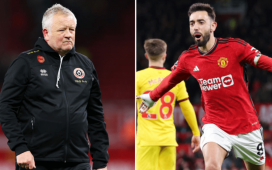To the Palace, then, for the 27th edition of a tournament that over its rich and eclectic history has come to occupy a cherished and strangely comforting place in the festive sporting calendar. Depressed by the election result? Fearful of climate change? Never mind: the darts is back on the telly and, for the next three weeks at least, everything’s going to be fine.
Of course, regular followers will be entitled to point out that darts is hardly ever off the telly these days, such has been the prodigious growth of the sport over the last two decades. And yet even in a fattened calendar, in a world of new stars and dizzying new frontiers, there remains a particular cachet to the world championship, a shared bloodline that connects your John Lowes and Eric Bristows to today’s sponsor-encrusted, mineral water‑supping superstars.
For the thousands of fans who will descend on Alexandra Palace over the next three weeks with their placards and their silly outfits it remains the highlight of the darting year. For players it remains the one tournament with the potential to cement their legend. The fact that the man or woman who holds aloft the Sid Waddell Trophy on 1 January will take home £500,000 in prize money – more than Phil Taylor did in winning his first 12 world titles put together – is, naturally, a fringe benefit.
Truly these are lavish times, and in more senses than one. Where once a three-dart average above 100 was a remarkable feat, for today’s best players it is simply a basis for negotiation. Of the 96 players in the field you could identify at least a couple of dozen who with a fair wind could mount a serious challenge. Dark horses and dangerous non‑seeds lurk in every section of the draw. And yet, for all this, any discussion of potential world champions ultimately tapers to a single, indomitable name.
Michael van Gerwen won last year’s world championship without really getting out of third gear. In his seven matches not only was he not challenged, he was not even close to being challenged. He did not trail once. His average did not dip below 100 once. An imperious starter and an imperious competitor, Van Gerwen has reached the stage of his career where his immense aura alone is probably worth a couple of sets’ head start. He tends to strengthen as a tournament progresses, as the format lengthens, as the stakes rise, as his outstanding cover-shooting and unshakeable nerve begin to tell.
Can anyone shift him? Of the chasing pack Gerwyn Price looks best equipped on current form. Few could have predicted, when he first made the switch from Welsh professional rugby union, that Price would be contending at the very highest level. But in successfully defending his Grand Slam title last month – sweeping aside Van Gerwen in the semi-final – Price displayed a quality even more valuable than heavy scoring and clutch doubling: big-time bravado. In a cast of colourful chancers and brash talkers Price genuinely seems to believe in his own destiny.

Beyond those two the field lies devastatingly open. Rob Cross, the world No2 and a shock winner in 2018, is defending the ranking points he won two years ago, which brings its own unique pressure. Michael Smith has kicked on impressively from the disappointment of losing last year’s final 7-3 to Van Gerwen – a match in which, it’s often forgotten, he missed darts to win five of the sets. Last year’s surprise semi-finalist Nathan Aspinall has a kind draw and some good wins under his belt.
Behind them are the established heavyweights. James Wade and Peter Wright are seasoned competitors with a consistently high level. Gary Anderson is a respected two-times champion whose gradual decline this year suggests the spark may have gone from his game. Adrian Lewis has already experienced that decline and is tentatively, intriguingly, emerging from the other side. All of them, on their day, have the game to defeat all comers.
And then there are wild cards: emerging players who could cut a swath through the draw. Glen Durrant, the triple Lakeside champion, has enjoyed a spectacular debut season since switching to the PDC, and is far more dangerous than his seeding of 27 would suggest. Chris Dobey and Joe Cullen are among the best of the younger generation.
Then there are the overseas challengers: the exciting Krzysztof Ratajski of Poland, Gabriel Clemens of Germany, the veteran Portuguese José de Sousa, all capable of greatness on their day.
If it seems as if half of the draw has been mentioned, then it’s merely a testament to the strength and depth in today’s game. Perhaps the most telling indication of this is Raymond van Barneveld, the five-times world champion who, at the age of 52, is calling time on his career after a slow, sad plummet from the summit.
Van Barneveld has not appreciably worsened as a player and, with the goodwill of the Palace crowd at his back, even a heart-warming swansong is not beyond him. But such is the ferocity of the competition, the unyielding grind of the tour, the unseemly scramble for ranking points in places like Barnsley and Wigan, that at some point even a great champion like Van Barneveld began to look out of his depth.
And so, in a way, he stands as a weathered artefact of the rapacious progress of darts: a sport where you sharpen, you evolve or you get left behind.














